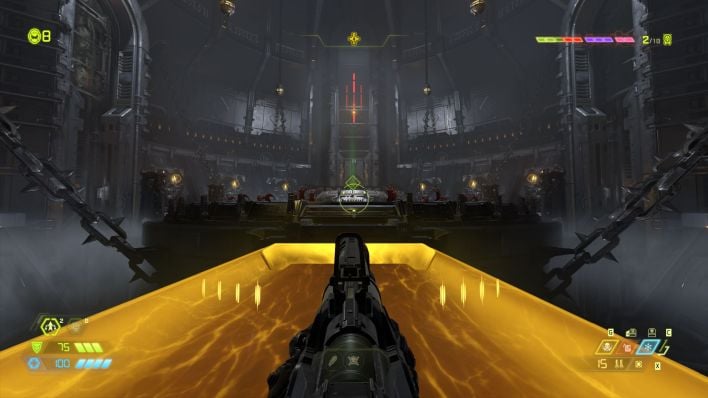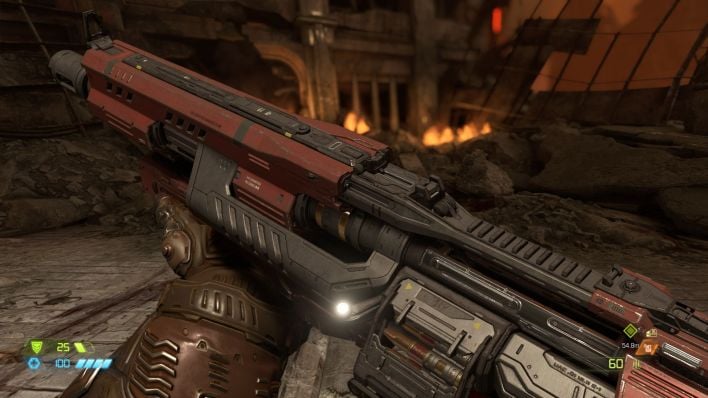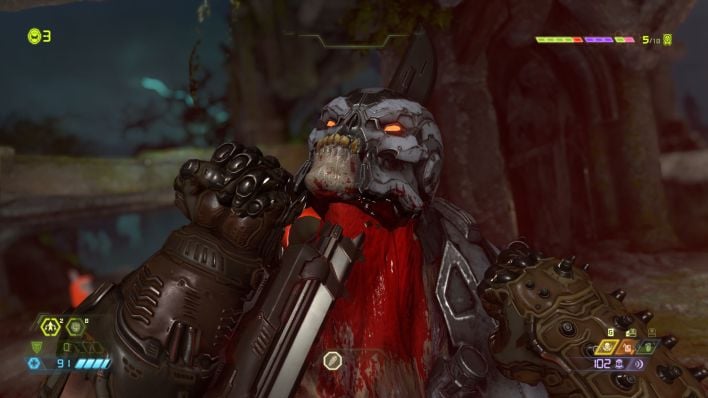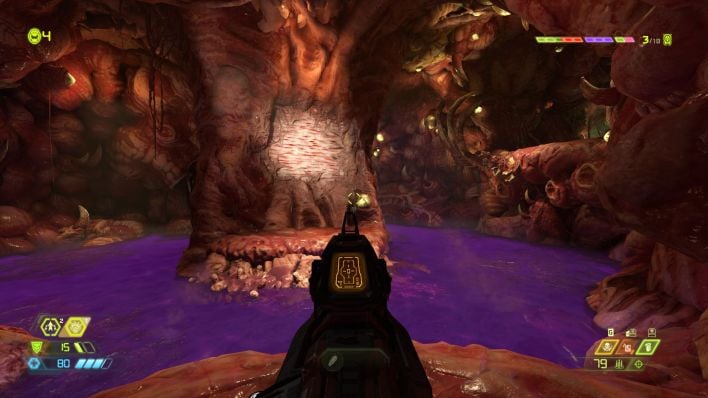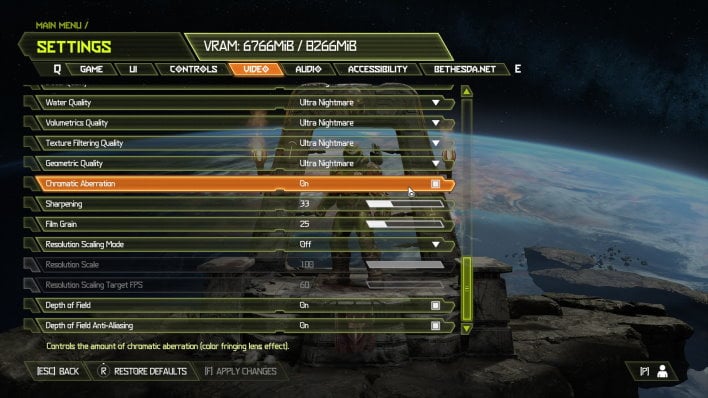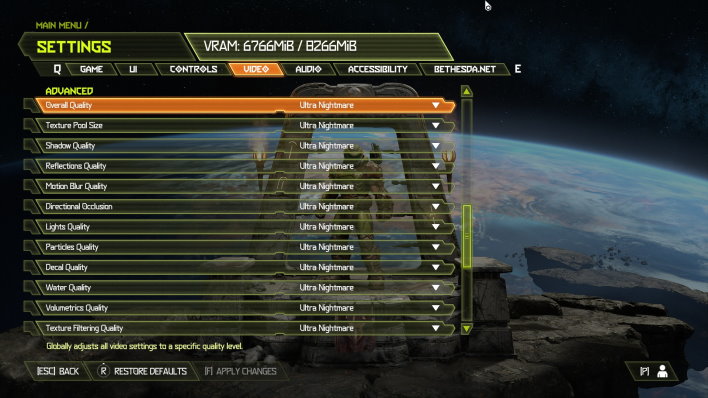Doom Eternal: Demon Killing Gameplay And GPU Performance Review
Doom Eternal: Amazing Graphics And Thrilling Gameplay
Update 3/25/2020: We've added results for the Radeon RX 5600 XT 6 GB to our tests and value charts.
Doom is a game franchise that needs no introduction. In 1992, id Software laid down the groundwork for first-person shooters with Wolfenstein 3D. When Doom came along a year later, the studio cemented its status among elite American game developers, thanks in no small part to the game's outstanding graphics and addictive gameplay. The series saw several releases up through 2005's Doom 3: BFG Edition, and then Doom went dormant. In 2016 after being acquired by Bethesda, id released a follow-up simply named Doom. That title was firmly rooted in what id does best: a smooth graphics engine and some really nice atmosphere with a coherent, but mostly forgettable story. Doom Eternal is the follow-up to that title, and it brings the demonic invasion home.
Set around eight months after the events of the rebooted Doom, the Doom Slayer (whom we graybeards called "Doomguy" in the 90s) has returned from Mars to find that Earth has been overrun by the forces of Hell. The demons, under the direction of the now-corrupted Union Aerospace Corporation, have killed more than half of humanity. Doom Eternal picks up in a wooden and steel underground area reminiscent of a Slayer album cover; you have to fight your way out and find three mysterious magicians who have unleashed hell on earth. From here, discussion of the plot stops because we don't want to give away any spoilers, and there's a whole lot more plot to spoil (or not) this time around, which is mostly told using in-engine cut scenes. Suffice it to say that if you enjoyed previous installments for their stories, there's a lot more here to dig into with Doom Eternal.
Frantic Run And Gun Action
Doom Eternal's core gameplay hasn't changed a whole lot from 2016's game, but the new features augment the previous installment's already pretty-good combat system. In the first game, Glory Kills—specialized melee kills similar to Mortal Kombat Fatalities minus the complex input sequences—were mostly for show and a way to conserve ammo. This time around, those specialty kills result in extra health pickups. If you're in the middle of a fight and need some health, it's a great way to recharge. The execution of these kills feels a little wonky, because enemies politely wait for you to complete a Glory Kill before they go back to pounding you. It breaks the immersion a little bit and makes the game feel like a Jackie Chan movie at times.Saving ammo is key because the maximum ammo load-out at the start of Doom Eternal is comically low. The Praetor Suit must be short on pocket space, because the Doom Slayer can only carry a small amount of ammo for each weapon at the start of the game. As a result, we have been looking for ammo constantly. Fortunately, the chainsaw, which has its own automatically refilling fuel source, can help. When ammo runs low, pressing "C" on the keyboard whips out the chainsaw, and if it catches an enemy, blood and...uh...ammo come out like some kind of demented demonic piñata. The Flame Belch is a handheld flamethrower that turns demons into armor vending machines. These are definitely "game mechanics" first and foremost, and it makes Doom Eternal feel more like an arcade game than a sci-fi survival horror game like the last entry.
Speaking of game mechanics, Doom Eternal channels Super Mario with its Extra Life system. Hidden throughout each mission are power-ups labeled "1 Up" that grant the player the ability to immediately recover from fatal damage once without going back to a checkpoint. Take that finishing blow and the screen turns gray and the Doom Slayer recovers to full health, ready to continue fighting. This can come in handy, but there's no way to control when the Doom Slayer uses it. More often than not, we'd get right past a checkpoint and die, consuming the extra life when restarting from the recently-passed checkpoint wouldn't have taken much effort. If you die at a checkpoint often enough, the game will offer to let you start with Sentinel Armor, which adds a whole lot of extra damage absorption, to make the coming fight easier, much like the white Tanooki suit in Super Mario 3D World or later.
One last game mechanic worth mentioning is enemy weak points. Each large enemy has a spot, like an evil scientist's Self Destruct button, that makes it easier to kill. Unfortunately, when playing with tutorials enabled, time will stop when you initially encounter one of these enemies and the game tells you the weak point. The first such encounter is the Arachnotron, which is a brain-looking creature with mechanical legs and a top-mounted plasma cannon, which is its weak point. Some of the weak points are lifted directly out of Looney Tunes' Bugs Bunny cartoons and bring a bit of levity to a game that otherwise takes itself pretty seriously. I don't want to give it away, but you'll have to find the Cacodemon and try hitting its weak point for yourself.
Bethesda describes Doom Eternal's fighting engine as a "combat puzzle," and that description checks out. To complete a fight, you'll have to mix in the right amount of Glory Kills and chainsaw massacres to get the health and ammo you need to sustain you through the next firefight. Demons come at you faster than Sonic the Hedgehog after a couple cans of Jolt cola, and they'll respawn right before your eyes as they teleport to Earth. While 2016's iteration had its frenetic moments, the entirety of each mission in Doom Eternal is one frantic fight from start to finish, with the occasional peaceful moment.
Thankfully, the Doom Slayer is also pretty fast and nimble. A double-jump and dash move combine to let players get around the campaign maps pretty easily. The environments are full of jump pads, climbable walls, and swingable beams, too. Using all of these is pretty intuitive and absolutely required to complete even the first mission, so you'll be shouting "parkour!" like Michael Scott in no time. Unfortunately, all of this comes to a grinding halt in one particular mission full of this purple goo that slows the Doom Slayer down a lot. The game is generally so fast and free that these portions suck the fun right out of it, and there's no easy or quick way around it. That's a pretty sour note for a game that plays so very sweetly more often than not.
In Doom Eternal, Customization Reigns
2016 Doom's Runes, which are special items that can slot into the Praetor Suit's Rune slots, are back in Doom Eternal. Rather than completing Rune Trials, this time you'll acquire them by exploring the environment. The most useful Runes I've found so far help with Glory Kills: Savagery lets you perform those kills more quickly, while the Seek and Destroy Rune lets you initiate a Glory Kill from farther away. There are also a handful of time-altering runes to be found, so you can temporarily slow down the action or recover from a fatal blow if you find the right secret items.Beyond Runes, Doom Eternal has plenty of customization options. The campaign's experience system awards experience at the end of each mission based on the number of secrets found, enemies killed, and so on. There are also some secret ways to earn XP that you'll discover as you go along. All of those points can be exchanged for additional health, armor, ammo capacity, and quite a bit more. It doesn't have the depth of, say, Skyrim or Fallout 4's leveling systems, but there's enough here to make each play-through have its own unique challenges.
Much of Doom Eternal's arsenal is comprised of weapons from previous games. Series vets will recognize the Combat Shotgun, Plasma Gun, BFG-9000 and so many other weapons that have returned from prior installments. Each weapon has a pair of modification slots where you can use stations spread throughout the levels to add abilities, like sticky bombs, sniper rifles, and tiny missiles. The limited nature of these stations means that you should be careful early on when picking mods. As we worked through missions, we found more mod stations, and eventually we got through enough stations to have both modifications on each weapon.
Doom's Multiplayer Mayhem
Doom Eternal's multiplayer focuses on Battlemode, a two-on-one frenzy that pits the Doom Slayer in a grudge match against a pair of demons with a generous helping of AI-controlled demons for added chaos. The players on the demon side can pick from one of several demon forms, each with its own set of attacks and special abilities. This is a seemingly unfair fight, since as long as one of the two demons has the Slayer in their sights, the other can see an outline. However, with all the AI demons milling about, it's a lot harder than it sounds.Meanwhile, the player playing as the Doom Slayer gets all of the campaign mode's extra abilities, including the Chainsaw, Glory Kills, and Fire Belch. The Slayer is also incredibly mobile, just like the campaign. Battlemode maps are full of the same jumps, monkey bars, and wall grips as the campaign, so there will be ample opportunity to get out of sight without any trouble. Just don't stop moving, and the Slayer will be fine.
Doom Eternal Is A Graphical Tour De Force
Being based on id Tech 6, Doom Eternal's id Tech 7 engine specializes in outstanding effects, sharp textures, and outstanding performance. Gone is the previous game's OpenGL renderer -- it's all Vulkan for this title. Frankly, it's hard to believe that a game looks so good and runs so well at the same time, even on relatively modest graphics cards and at lower settings. If you haven't seen our guide to optimizing performance be sure to check it out, but rest assured that Doom Eternal runs great on any given hardware configuration. We're going to talk more about that in the next section, but it needed to be said here.Along with great performance, id Tech 7 brings some new features to the table. The engine fully supports HDR lighting and shadowing on PC and consoles, better global illumination, and a maximum 1000 frames per second limit. While monitors these days top out at 240 Hz, that gives plenty of room to grow, especially if high-speed OLED panels take off. This iteration of id's engine goes all-in on physically-based rendering, too. Gone is the Mega Texture pipeline, which has been a staple of id's engines since Rage, and with it comes enhanced texturing capabilities as a result.
The most obvious enhancement to id Tech 7 is the Destructible Demon System, in which enemy models become progressively destroyed as they take damage. The destruction is generated based on where each shot hits them, so when you (for instance) shoot a demon in the leg, the model might lose a part of that leg. It's simultaneously gross and really engrossing all at once, making it a beautiful train wreck from which you cannot look away.
id Tech 7 also supports game areas twice as large as the previous version of the engine, and that really shows in level design. When playing from the start of any given mission all the way to the end, we never saw a single obvious loading screen or loading mask, like a fade out, fade in, or pointless tunnel while gaming. While the game obviously had to load data at some point, the areas were huge and varied, but never showed any signs of slowdown or stuttering.
Doom Eternal has six different settings available for each feature, labeled from Low to Ultra Nightmare, and we'll look at three of them together. The differences are pretty stark between Low and Ultra (with Medium and High in between) but far less obvious when going from the Ultra preset to Nightmare or Ultra Nightmare. In our screenshots below, the lower-resolution textures and lighting are immediately apparent on the Low setting, but beyond that they're awfully hard to tell apart.

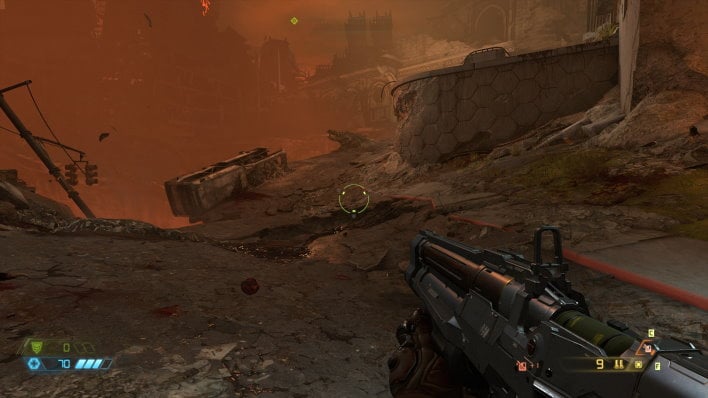

Ultra Nightmare is the highest detail level. Here, all of the effects, models, and textures are at their max.
One of the more foolproof ways we've seen of preventing a user from setting detail levels too high for the hardware is that Doom Eternal has pre-conceived requirements for each level of texture and shadow map detail. If your graphics card has 4 GB of VRAM, you won't be able to choose anything higher than High. For cards with 6 GB of memory like the GeForce GTX 1660 SUPER, GeForce RTX 2060, and Radeon RX 5600 XT, the Ultra Texture Pool is the limit. Once a graphics card has at least 8 GB of memory, only then can Ultra Nightmare textures be selected. That's important to bear in mind when we test the RTX 2060 later on, because even on the Ultra Nightmare setting, we had to lower texture detail by a couple of notches.
Doom Eternal Benchmark Test Methodologies
Doom Eternal does not have any sort of pre-baked demo or benchmark built in, so we collected data for these runs manually. Just like in our review of Remedy's Control, we picked a section of the game with an easily-repeatable start and end point, and collected frame times with CapFrameX. Thanks to the miracle of Microsoft Excel, we turned those frame times into frames per second averages and frame time graphs, which show smoothness over time in a clear and concise manner.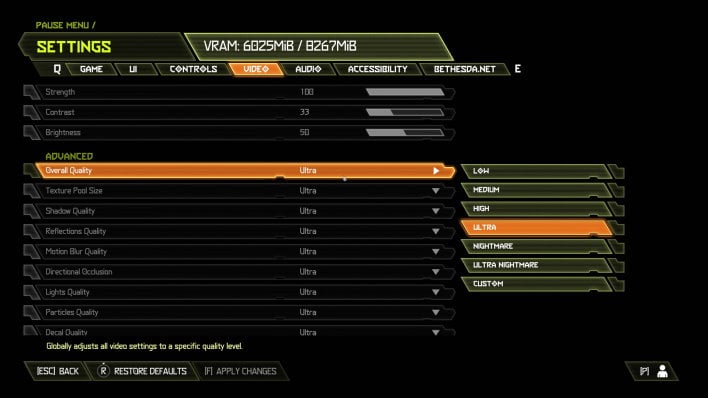
Our test rig includes an eight-core AMD Ryzen 7 3700X on an Asus TUF Gaming X570-Plus Wi-Fi motherboard with 32 GB of Corsair LPX DDR4-3200 memory. We played Doom Eternal from an Addlink S70 1 TB NVMe SSD to minimize any impact storage might have on the game. That's a pretty beefy system by any standard, and as a result we expect our frame rates to be pretty GPU limited. The test system had Windows 10 with the Fall 2019 update (1909) and all updates through March's Patch Tuesday. For NVIDIA cards, we had the latest Game Ready 442.74 GeForce drivers. Our AMD cards ran the latest 2020.3.1 Radeon Adrenaline Edition software.
We should note that these tests were performed under duress—we started recording at a checkpoint in the first mission, Hell On Earth, that leads into a big firefight that includes the first run-in with the cyborg brain-looking Arachnotron. Because of the manual nature of our tests, there's a little variance in our benchmark from run to run, but we always followed the same path and captured a longer period of gameplay than most in-game benchmarks to try to smooth out any differences.
Without further ado, let's see how our test rig handles Doom Eternal...


